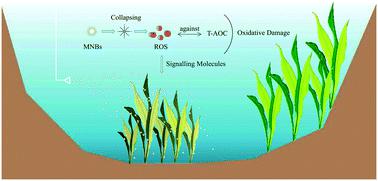当前位置:
X-MOL 学术
›
Environ. Sci.: Water Res. Technol.
›
论文详情
Our official English website, www.x-mol.net, welcomes your feedback! (Note: you will need to create a separate account there.)
Micro-nanobubble aeration promotes senescence of submerged macrophytes with low total antioxidant capacity in urban landscape water
Environmental Science: Water Research & Technology ( IF 5 ) Pub Date : 2019-11-21 , DOI: 10.1039/c9ew00929a Shuo Wang 1, 2, 3, 4 , Yunsi Liu 1, 2, 3, 4 , Pan Li 1, 1, 2, 3, 4 , Ying Wang 5, 6, 7, 8, 9 , Jinshui Yang 5, 6, 7, 8, 9 , Wen Zhang 10, 11, 12, 13
Environmental Science: Water Research & Technology ( IF 5 ) Pub Date : 2019-11-21 , DOI: 10.1039/c9ew00929a Shuo Wang 1, 2, 3, 4 , Yunsi Liu 1, 2, 3, 4 , Pan Li 1, 1, 2, 3, 4 , Ying Wang 5, 6, 7, 8, 9 , Jinshui Yang 5, 6, 7, 8, 9 , Wen Zhang 10, 11, 12, 13
Affiliation

|
Rapid industrialization and urbanization have contributed to eutrophication of urban landscape water in China. As an important part of aquatic ecosystems, macrophytes have many advantages in controlling eutrophication and algal blooms. In recent years, micro-nanobubble (MNB) aeration has increasingly been used for restoring natural waters suffering from eutrophication, which may affect the growth of macrophytes and thereby affect ecological restoration, but the effect of MNBs on macrophytes has not drawn great attention. In this study, three common species of macrophytes (Echinodorus amazonicus or EA, Echinodorus quadricostatus or EQ and Microsorum pteropus or MP) were grown for 60 days in water aerated with MNBs and their growth was compared to that of the same plants grown with standard macrobubble aeration. The growth of EA and EQ was significantly inhibited by MNB aeration, and was accompanied by various symptoms of senescence (yellowing and chlorophyll degradation, the decrease of photosynthesis rate, carbon fixation and plant growth, and the decline of respiration rate). However, the growth of MP plants was not significantly affected under the same conditions. The final fresh weights (FFWs) of EA, EQ and MP in the presence of high MNB levels were 0.75, 0.83 and 1.05 times those in the macrobubble aeration system; we designate this parameter ratioFFW. We found the initial total antioxidant capacity (T-AOC) of EA and EQ to be 48.00 and 64.67 U mL−1, respectively, markedly lower than that of MP (617.33 U mL−1). The ratioFFW values and other growth indexes of the three plant species were positively correlated with their T-AOC. Macrophytes use their antioxidant defense mechanisms to prevent oxidative damage by ROS, while still allowing exogenous ROS to function as signalling molecules to regulate plant growth and senescence. Premature senescence is a protective mechanism employed when plants are stressed and their growth is consequently inhibited. Our results suggest that instead of positively promoting the growth of dense macrophytes, the MNBs potentially induce damage to water ecosystem.
更新日期:2019-11-21



























 京公网安备 11010802027423号
京公网安备 11010802027423号